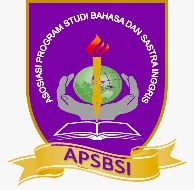THE USE OF BLOG AS A MEDIUM TO IMPROVE STUDENTS` SKILL IN WRITING HORTATORY EXPOSITION A Classroom Action Research at the Eleventh Grade Students of SMAN 12 Semarang
Abstract
The purposes of this study are to investigate students’ problems in writing hortatory exposition, to explain why students have problems in writing hortatory exposition, and to find out how well does blog contribute in improving students’ mastery of writing hortatory exposition In constructing this study, the writer collected data using a classroom action research, which was carried out through four activities. The activities consisted of planning, acting, observing and reflecting. The subjects of this study were 37 students of year eleven of SMA NEGERI 12 SEMARANG in the academic year of 2011/2012. The action was done through teaching learning process. All of the teaching learning processes were presented by the help of blog.The data was analyzed qualitatively, to find the answers. Based on the data analysis from each activity, it can be seen that the students’ problems in writing hortatory exposition text were the difficulty in drawing contents, organizing text, using the language and vocabulary, and mastering the mechanics. They were caused by the lack of students’ attention, enthusiasm, activeness in asking answering questions and activeness in doing the task given by the teacher. It was found that there was a significant difference of the students’ skill in writing hortatory exposition from the pre-test, first cycle and second cycle. After the treatments, the students’ achievement in writing hortatory exposition text was improved. Therefore, using blog as a medium was effective to improve the students’ writing skill in hortatory exposition text and very beneficial for the students in order to facilitate them in learning English.To explore the advantages of using blog in teaching learning process, in the future study, not only the teachers, but also the students are also recommended to possess blog accounts. By possessing their own blog accounts, students are supposed to compose the blog posts and explore the references of their writings by themselves. It also abridges the students to share their writings and testimonials to the others’ blogs. In this way, the frequency of the communication practice and word building gradually increases that is expected to be able to improve students’ writing skill, especially in hortatory exposition text, and generally in all other text types.
References
Arikunto, S., 1996, Prosedur Penelitian: Suatu Pendekatan Praktek, Jakarta: Rineka Cipta.
Best, J. W. 1981. Research and Education. New Jersey: Prentice Hall. Inc.
Brown, H. D. 2004. Language Assessment Principles and Classroom Practices. New York: Pearson Education Limited.
Brown, W. J. 1977. Educational Media Yearbook. New York: rr Browker.
Brooks, K., C. Nichols, and S. Priebe. 2004. Remediation, Genre, and Motivation:
Key Concepts for Teaching with Weblogs.
Gurak, L. et al. (nd) Into the Blogosphere: Rhetoric, Community, and Culture of Weblogs. www.blog.lib.umn.edu/blogosphere [accessed 02/29/12]
Cahyono, K. D. and E. Purnama. 2006. Communicative Competence 2B: A course in Acquiring English Communicative Competence, For Senior High School Level, Grade XI Semester 2. www.text-types.com/2011/01/hortatory-exposition-text-campaign-of.html [accessed 01/10/12]
Creswell, J. W. 2005. Educational Research: Planning, Conducting and Evaluating Quantitative and Qualitative Research. New York: University of Michigan.
Drexler et al. 2007. Collaborative Blogging as a Means to Develop Elementary Expository Writing Skills. Electronic Journal for the Integration of Technology in Education, Vol. 6. 140 160.
Finocchiaro, M. 1974. English as a Second Language. From Theory to Practice. New York: Regents Publishing Company, Inc.
Gerlach, V. S., P. E. Donald and R. Melnick. 1980. Teaching and Media: A sistematic Approach. University of Michigan: Prentice Hall.
Gerot, L and P. Wignell.1994. Making Sense of Grammatical. Sydney: Gerd Stabler.
Halliday, M.A.K. and R. Hasan. 1985. Language, Context, and Text: Aspects of Language in Social-Semiotic Perspective. London: Oxford University Press.
Harmer, J. 2001. The Practice of English Language Teaching. Longman: Essex.
Harris. P. D. 1969. Testing English as a Second Language. Mc. Graw-Hill Book Company: USA.
Hartoyo. 2010. Academic Writing. Semarang.
Harvey, C. 2010. ESL Composition Profile. Maryville: Unpublished article.
Larsen-Freeman, D. 1996. Techniques and Principles in Language Teaching. New
York: Oxford University Press.
Locatis, C. and F. D. Atkinson. 1984. Media and Technology for Education and Training. Columbus, Ohio: C.E. Merril Pub. Co.
Lowe, C. 2004. Moving to the public: Weblogs in the writing classroom. Into the Blogosphere. http://Blog.lib.umn.edu//blogosphere/moving_to_public_pf.html [accessed 01/23/13]
Maddux, C. D. and J. D. Lamont. 2006. Type II Uses Technology in Education: Project, Case Studies, and Software Application.
Mills, G. E. 2010. Action Research: A Guide for the Teacher Researcher. Pennsylvania State University: Pearson.
Murcia, Marianne C. 2001. Teaching English as A Second or Foreign Language. Heinle & Heinle.
Mynard, J. 2007. Professional Teaching Articles: A blog as a Tool for Reflection for English Language Learners. Japan: Koryo International College.
Pinkman, K. 2005. Using Blogs in the Foreign Classroom: Encouraging learner
independence. JALT CALL Journal, 1(1): 12-24.
Rozgiene, Inga, Olga Medvedeva, Zuzana Strakov. 2008. Integrating ICT into Language Learning and Teaching. Altenberger :Johannes Kepler Universitt Linz.
Subyantoro. 2009. Penelitian Tindakan Kelas. Semarang: Badan Penerbit Undip and CV. Widya Karya.
Tuckman, B. W. 1999. Conducting Educational Research. University of Michigan: Harcourt Brace College Publishers.
Vurdien, Ruby. 2011. Enhancing writing skills through blogs in an EFL class. Spain: White Rose Language School.
White, R. and A. Maley. 1987. Writing: Advanced. New York: Oxford University Press.


_.jpg)
_.jpg)




